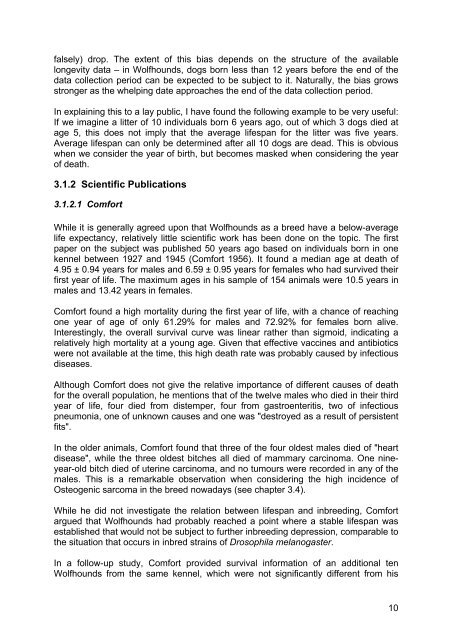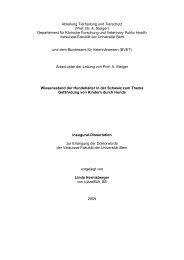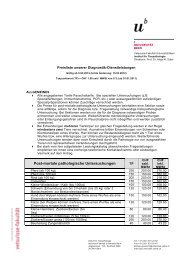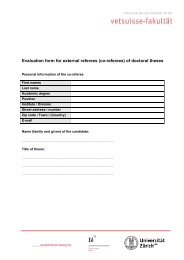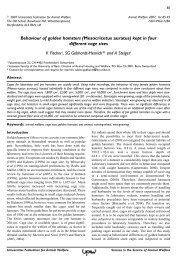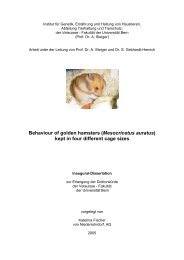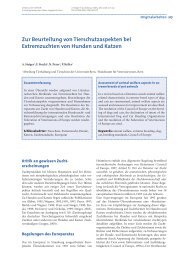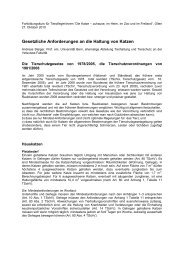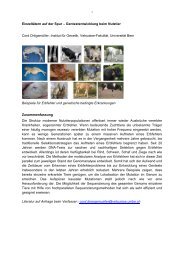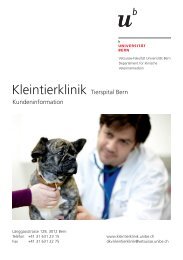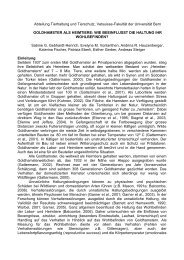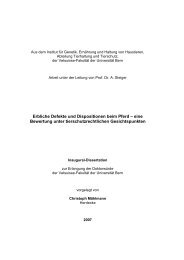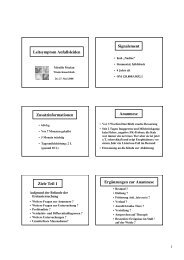Lifespan and Causes of Death in the Irish Wolfhound - Vetsuisse ...
Lifespan and Causes of Death in the Irish Wolfhound - Vetsuisse ...
Lifespan and Causes of Death in the Irish Wolfhound - Vetsuisse ...
Create successful ePaper yourself
Turn your PDF publications into a flip-book with our unique Google optimized e-Paper software.
falsely) drop. The extent <strong>of</strong> this bias depends on <strong>the</strong> structure <strong>of</strong> <strong>the</strong> available<br />
longevity data – <strong>in</strong> <strong>Wolfhound</strong>s, dogs born less than 12 years before <strong>the</strong> end <strong>of</strong> <strong>the</strong><br />
data collection period can be expected to be subject to it. Naturally, <strong>the</strong> bias grows<br />
stronger as <strong>the</strong> whelp<strong>in</strong>g date approaches <strong>the</strong> end <strong>of</strong> <strong>the</strong> data collection period.<br />
In expla<strong>in</strong><strong>in</strong>g this to a lay public, I have found <strong>the</strong> follow<strong>in</strong>g example to be very useful:<br />
If we imag<strong>in</strong>e a litter <strong>of</strong> 10 <strong>in</strong>dividuals born 6 years ago, out <strong>of</strong> which 3 dogs died at<br />
age 5, this does not imply that <strong>the</strong> average lifespan for <strong>the</strong> litter was five years.<br />
Average lifespan can only be determ<strong>in</strong>ed after all 10 dogs are dead. This is obvious<br />
when we consider <strong>the</strong> year <strong>of</strong> birth, but becomes masked when consider<strong>in</strong>g <strong>the</strong> year<br />
<strong>of</strong> death.<br />
3.1.2 Scientific Publications<br />
3.1.2.1 Comfort<br />
While it is generally agreed upon that <strong>Wolfhound</strong>s as a breed have a below-average<br />
life expectancy, relatively little scientific work has been done on <strong>the</strong> topic. The first<br />
paper on <strong>the</strong> subject was published 50 years ago based on <strong>in</strong>dividuals born <strong>in</strong> one<br />
kennel between 1927 <strong>and</strong> 1945 (Comfort 1956). It found a median age at death <strong>of</strong><br />
4.95 ± 0.94 years for males <strong>and</strong> 6.59 ± 0.95 years for females who had survived <strong>the</strong>ir<br />
first year <strong>of</strong> life. The maximum ages <strong>in</strong> his sample <strong>of</strong> 154 animals were 10.5 years <strong>in</strong><br />
males <strong>and</strong> 13.42 years <strong>in</strong> females.<br />
Comfort found a high mortality dur<strong>in</strong>g <strong>the</strong> first year <strong>of</strong> life, with a chance <strong>of</strong> reach<strong>in</strong>g<br />
one year <strong>of</strong> age <strong>of</strong> only 61.29% for males <strong>and</strong> 72.92% for females born alive.<br />
Interest<strong>in</strong>gly, <strong>the</strong> overall survival curve was l<strong>in</strong>ear ra<strong>the</strong>r than sigmoid, <strong>in</strong>dicat<strong>in</strong>g a<br />
relatively high mortality at a young age. Given that effective vacc<strong>in</strong>es <strong>and</strong> antibiotics<br />
were not available at <strong>the</strong> time, this high death rate was probably caused by <strong>in</strong>fectious<br />
diseases.<br />
Although Comfort does not give <strong>the</strong> relative importance <strong>of</strong> different causes <strong>of</strong> death<br />
for <strong>the</strong> overall population, he mentions that <strong>of</strong> <strong>the</strong> twelve males who died <strong>in</strong> <strong>the</strong>ir third<br />
year <strong>of</strong> life, four died from distemper, four from gastroenteritis, two <strong>of</strong> <strong>in</strong>fectious<br />
pneumonia, one <strong>of</strong> unknown causes <strong>and</strong> one was "destroyed as a result <strong>of</strong> persistent<br />
fits".<br />
In <strong>the</strong> older animals, Comfort found that three <strong>of</strong> <strong>the</strong> four oldest males died <strong>of</strong> "heart<br />
disease", while <strong>the</strong> three oldest bitches all died <strong>of</strong> mammary carc<strong>in</strong>oma. One n<strong>in</strong>eyear-old<br />
bitch died <strong>of</strong> uter<strong>in</strong>e carc<strong>in</strong>oma, <strong>and</strong> no tumours were recorded <strong>in</strong> any <strong>of</strong> <strong>the</strong><br />
males. This is a remarkable observation when consider<strong>in</strong>g <strong>the</strong> high <strong>in</strong>cidence <strong>of</strong><br />
Osteogenic sarcoma <strong>in</strong> <strong>the</strong> breed nowadays (see chapter 3.4).<br />
While he did not <strong>in</strong>vestigate <strong>the</strong> relation between lifespan <strong>and</strong> <strong>in</strong>breed<strong>in</strong>g, Comfort<br />
argued that <strong>Wolfhound</strong>s had probably reached a po<strong>in</strong>t where a stable lifespan was<br />
established that would not be subject to fur<strong>the</strong>r <strong>in</strong>breed<strong>in</strong>g depression, comparable to<br />
<strong>the</strong> situation that occurs <strong>in</strong> <strong>in</strong>bred stra<strong>in</strong>s <strong>of</strong> Drosophila melanogaster.<br />
In a follow-up study, Comfort provided survival <strong>in</strong>formation <strong>of</strong> an additional ten<br />
<strong>Wolfhound</strong>s from <strong>the</strong> same kennel, which were not significantly different from his<br />
10


